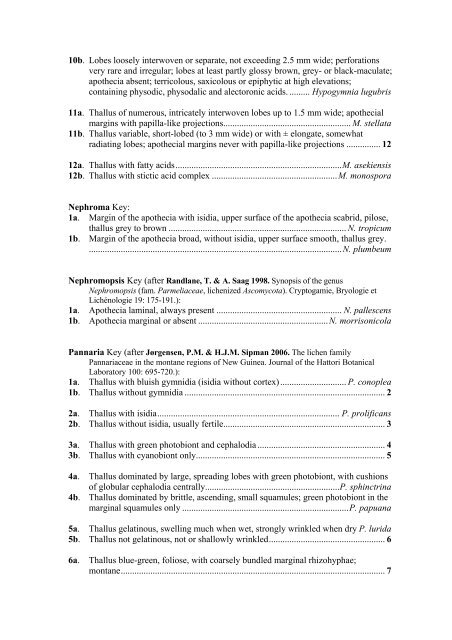Keys to the macrolichens and checklist of the lichens and ...
Keys to the macrolichens and checklist of the lichens and ...
Keys to the macrolichens and checklist of the lichens and ...
You also want an ePaper? Increase the reach of your titles
YUMPU automatically turns print PDFs into web optimized ePapers that Google loves.
10b. Lobes loosely interwoven or separate, not exceeding 2.5 mm wide; perforations<br />
very rare <strong>and</strong> irregular; lobes at least partly glossy brown, grey- or black-maculate;<br />
apo<strong>the</strong>cia absent; terricolous, saxicolous or epiphytic at high elevations;<br />
containing physodic, physodalic <strong>and</strong> alec<strong>to</strong>ronic acids. ......... Hypogymnia lugubris<br />
11a. Thallus <strong>of</strong> numerous, intricately interwoven lobes up <strong>to</strong> 1.5 mm wide; apo<strong>the</strong>cial<br />
margins with papilla-like projections........................................................ M. stellata<br />
11b. Thallus variable, short-lobed (<strong>to</strong> 3 mm wide) or with ± elongate, somewhat<br />
radiating lobes; apo<strong>the</strong>cial margins never with papilla-like projections ............... 12<br />
12a. Thallus with fatty acids.........................................................................M. asekiensis<br />
12b. Thallus with stictic acid complex .......................................................M. monospora<br />
Nephroma Key:<br />
1a. Margin <strong>of</strong> <strong>the</strong> apo<strong>the</strong>cia with isidia, upper surface <strong>of</strong> <strong>the</strong> apo<strong>the</strong>cia scabrid, pilose,<br />
thallus grey <strong>to</strong> brown .............................................................................. N. tropicum<br />
1b. Margin <strong>of</strong> <strong>the</strong> apo<strong>the</strong>cia broad, without isidia, upper surface smooth, thallus grey.<br />
...............................................................................................................N. plumbeum<br />
Nephromopsis Key (after R<strong>and</strong>lane, T. & A. Saag 1998. Synopsis <strong>of</strong> <strong>the</strong> genus<br />
Nephromopsis (fam. Parmeliaceae, lichenized Ascomycota). Cryp<strong>to</strong>gamie, Bryologie et<br />
Lichénologie 19: 175-191.):<br />
1a. Apo<strong>the</strong>cia laminal, always present ....................................................... N. pallescens<br />
1b. Apo<strong>the</strong>cia marginal or absent .........................................................N. morrisonicola<br />
Pannaria Key (after Jørgensen, P.M. & H.J.M. Sipman 2006. The lichen family<br />
Pannariaceae in <strong>the</strong> montane regions <strong>of</strong> New Guinea. Journal <strong>of</strong> <strong>the</strong> Hat<strong>to</strong>ri Botanical<br />
Labora<strong>to</strong>ry 100: 695-720.):<br />
1a. Thallus with bluish gymnidia (isidia without cortex)............................. P. conoplea<br />
1b. Thallus without gymnidia ........................................................................................ 2<br />
2a. Thallus with isidia................................................................................ P. prolificans<br />
2b. Thallus without isidia, usually fertile....................................................................... 3<br />
3a. Thallus with green pho<strong>to</strong>biont <strong>and</strong> cephalodia ........................................................ 4<br />
3b. Thallus with cyanobiont only................................................................................... 5<br />
4a. Thallus dominated by large, spreading lobes with green pho<strong>to</strong>biont, with cushions<br />
<strong>of</strong> globular cephalodia centrally...........................................................P. sphinctrina<br />
4b. Thallus dominated by brittle, ascending, small squamules; green pho<strong>to</strong>biont in <strong>the</strong><br />
marginal squamules only .........................................................................P. papuana<br />
5a. Thallus gelatinous, swelling much when wet, strongly wrinkled when dry P. lurida<br />
5b. Thallus not gelatinous, not or shallowly wrinkled................................................... 6<br />
6a. Thallus blue-green, foliose, with coarsely bundled marginal rhizohyphae;<br />
montane.................................................................................................................... 7




